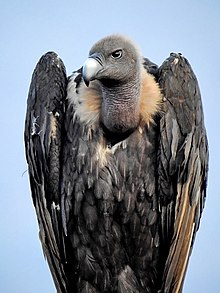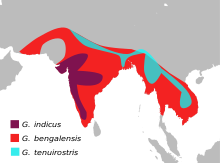
A vulture is a bird of prey that scavenges on carrion. There are 23 extant species of vulture. Old World vultures include 16 living species native to Europe, Africa, and Asia; New World vultures are restricted to North and South America and consist of seven identified species, all belonging to the Cathartidae family. A particular characteristic of many vultures is a bald, unfeathered head. This bare skin is thought to keep the head clean when feeding, and also plays an important role in thermoregulation.

Old World vultures are vultures that are found in the Old World, i.e. the continents of Europe, Asia and Africa, and which belong to the family Accipitridae, which also includes eagles, buzzards, kites, and hawks.

The Eurasian griffon vulture is a large Old World vulture in the bird of prey family Accipitridae. It is also known as the Griffon vulture, although this term is sometimes used for the genus as a whole. It is not to be confused with the Rüppell's griffon vulture and Himalayan griffon vulture. It is closely related to the white-backed vulture.
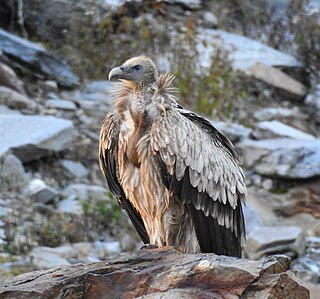
The Himalayan vulture or Himalayan griffon vulture is an Old World vulture native to the Himalayas and the adjoining Tibetan Plateau. It is one of the two largest Old World vultures and true raptors. It is listed as Near Threatened on the IUCN Red List. It is not to be confused with the Eurasian griffon vulture, which is a similar and sympatric species.
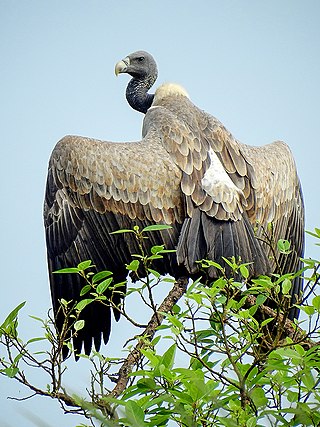
The Indian vulture or long-billed vulture is a bird of prey native to the Indian subcontinent. It is an Old World vulture belonging to the family of Accipitridae. It is a medium-sized vulture with a small, semi-bald head with little feathers, long beak, and wide dark colored wings. It breeds mainly on small cliffs and hilly crags in central and peninsular India.

The hooded vulture is an Old World vulture in the order Accipitriformes, which also includes eagles, kites, buzzards and hawks. It is the only member of the genus Necrosyrtes, which is sister to the larger Gyps genus, both of which are a part of the Aegypiinae subfamily of Old World vultures. It is native to sub-Saharan Africa, where it has a widespread distribution with populations in southern, East and West Africa. It is a scruffy-looking, small vulture with dark brown plumage, a long thin bill, bare crown, face and fore-neck, and a downy nape and hind-neck. Its face is usually a light red colour. It typically scavenges on carcasses of wildlife and domestic animals. Although it remains a common species with a stable population in the lower region of Casamance, some areas of The Gambia, and Guinea-Bissau, other regions such as Dakar, Senegal, show more than 85% losses in population over the last 50 years. Threats include poisoning, hunting, loss of habitat and collisions with electricity infrastructure, and the International Union for Conservation of Nature has rated its conservation status as "critically endangered" in their latest assessment (2022). The highest current regional density of hooded vultures is in the western region of The Gambia.
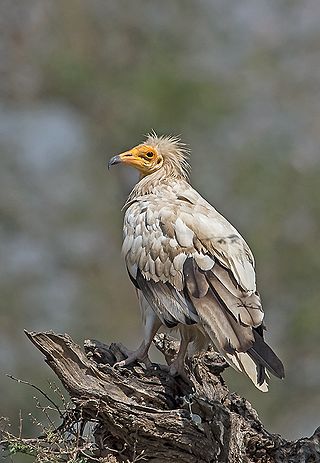
The Egyptian vulture, also called the white scavenger vulture or pharaoh's chicken, is a small Old World vulture in the monotypic genus Neophron. It is widely distributed from the Iberian Peninsula, North Africa, West Asia and India. The contrasting underwing pattern and wedge-shaped tail make it distinctive in flight as it soars in thermals during the warmer parts of the day. Egyptian vultures feed mainly on carrion but are opportunistic and will prey on small mammals, birds, and reptiles. They also feed on the eggs of other birds, breaking larger ones by tossing a large pebble onto them.

The white-backed vulture is an Old World vulture in the family Accipitridae, which also includes eagles, kites, buzzards and hawks. It is the most common vulture species in the continent of Africa.

The cinereous vulture is a large raptor in the family Accipitridae and distributed through much of temperate Eurasia. It is also known as the black vulture, monk vulture and Eurasian black vulture. With a body length of 1.2 m, 3.1 m (10 ft) across the wings and a maximum weight of 14 kg (31 lb), it is the largest Old World vulture and largest member of the Accipitridae family.

Rüppell's vulture, also called Rüppell's griffon vulture, named after Eduard Rüppell, is a large bird of prey, mainly native to the Sahel region and East Africa. The former population of 22,000 has been decreasing due to loss of habitat, incidental poisoning, and other factors. Known also as Rüppell's griffon, Rueppell's griffon, Rüppell's griffin vulture, Rueppell's vulture and other variants, it is not to be confused with a different species, the griffon vulture. Rüppell's vulture is considered to be the highest-flying bird, with confirmed evidence of a flight at an altitude of 11,300 m (37,000 ft) above sea level.

The Cape vulture, also known as Cape griffon and Kolbe's vulture, is an Old World vulture in the family Accipitridae. It is endemic to southern Africa, and lives mainly in South Africa, Lesotho, Botswana, and in some parts of northern Namibia. It nests on cliffs and lays one egg per year. In 2015, it had been classified as Endangered on the IUCN Red List, but was down-listed to Vulnerable in 2021 as some populations increased and have been stable since about 2016.
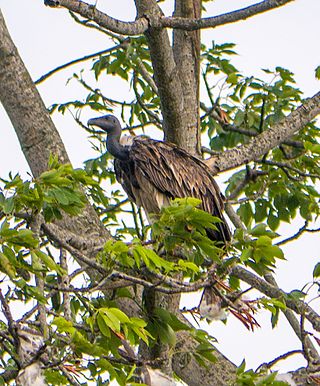
The slender-billed vulture is an Old World vulture species native to sub-Himalayan regions and Southeast Asia. It is Critically Endangered since 2002 as the population on the Indian subcontinent has declined rapidly. As of 2021, fewer than 870 mature individuals are thought to remain.

Mudumalai National Park is a national park in the Nilgiri Mountains in Tamil Nadu in southern India. It covers 321 km2 (124 sq mi) at an elevation range of 850–1,250 m (2,790–4,100 ft) in the Nilgiri District and shares boundaries with the states of Karnataka and Kerala. A part of this area has been protected since 1940. The national park has been part of Nilgiri Biosphere Reserve since 1986 and was declared a tiger reserve together with a buffer zone of 367.59 km2 (141.93 sq mi) in 2007. It receives an annual rainfall of about 1,420 mm (56 in) and harbours tropical and subtropical moist broadleaf forests with 498 plant species, at least 266 bird species, 18 carnivore and 10 herbivore species. It is drained by the Moyar River and several tributaries, which harbour 38 fish species.

The red-headed vulture, also known as the Asian king vulture, Indian black vulture or Pondicherry vulture, is an Old World vulture mainly found in the Indian subcontinent, with small disjunct populations in some parts of Southeast Asia.

The white-headed vulture is an Old World vulture endemic to Africa. Populations have been declining steeply in recent years due to habitat degradation and poisoning of vultures at carcasses. An extinct relative was also present in the Indonesian island of Flores during the Late Pleistocene, indicating that the genus was more widespread in the past.

Nine species of vulture can be found living in India, but most are now in danger of extinction after a rapid and major population collapse in recent decades. In the early 1980s, three species of Gyps vultures had a combined estimated population of 40 million in South Asia, while in 2017 the total population numbered only 19,000.

The Jatayu and Sparrow Conservation Breeding Centre (JCBC), is the world's largest facility for the breeding and conservation of Indian vultures and the house sparrow. It is located within the Bir Shikargah Wildlife Sanctuary in the town of Pinjore in the State of Haryana, India. It is run by the Haryana Forests Department and Bombay Natural History Society with the help of British nature conservation charity Royal Society for the Protection of Birds. It is 8 kilometres (5.0 mi) from Pinjore and covers 5 acres (2.0 ha).
A vulture restaurant is a site where carrion, decaying flesh from dead animals, is deposited in order to be consumed by vultures, and is sometimes referred to more generally as supplemental feeding or provisioning. These stations can also be referred to as vulture feeding sites, vulture feeding stations, and vulture safe zones. This supplemental feeding practice is used to provide vultures with reliable, non-contaminated food sources or to aid in monitoring schemes. Vulture restaurants have been instituted as a method of vulture conservation in Europe and Africa since the 1960's and 70's, when vulture populations began to decline. This strategy is used because often population declines are attributed to low food availability, food contamination or insufficient nutritional quality, or feeding from human areas leading to conflict. Notably, large vulture population declines in South Asia, referred to as the Asian or Indian vulture crisis, and Africa, referred to as the African vulture crisis, have brought renewed attention to the uses and impacts of vulture restaurants. Vulture restaurants are used in Asia, Africa, Europe, and North America for various conservation and management plans. They can help combat food-derived threats to vultures, such as diclofenac or lead contamination or conflict with ranchers and poachers. The first vulture restaurant was built in South Africa in 1966. Vulture restaurants operate in a number of countries, including Nepal, India, Cambodia, South Africa, Eswatini, and Spain.
Debbie Pain is a conservation biologist and ecotoxicologist working on endangered birds around the world. Since 1988 she has led projects into reversing the decline in several species through research, practical and policy measures at the Royal Society for the Protection of Birds and Wildlife and Wetlands Trust.
